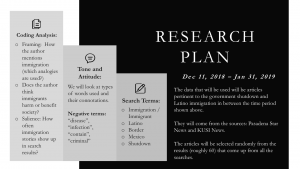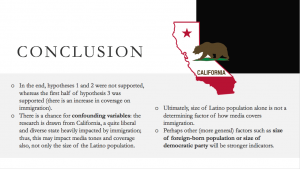

Slide 1: This first slide outlines the hypotheses that will be tested for the project. Branton and Dunway, in their work “Spatial Proximity to the U.S.-Mexico Border and Newspaper Coverage of Immigration Issues,” find that an area with a Latino population of over 25%, then media coverage of Latino immigration will be less than a district with a Latino population of under 25%. They also find that the closer a district is to the U.S.-Mexico border, the more likely it is to have negative media coverage of Latino immigration (Branton and Dunway 2009). With this, the media sources being compared are a news media local to CA27 (Pasadena Star News) and a media source belonging to a district nearer to the border and one that has a lower Latino population percentage (CA52 – KUSI News). We thus hypothesize that Pasadena Star News should have less media coverage of the Latino population and should be less negative than that of KUSI News. Additionally, Abrajano and Hajnal, in White Blacklash: Immigration, Race, and American Politics, conclude that media coverage of immigration increases as the foreign born population increases. Since both districts saw a steady rise in immigration since 10 years ago (by at least 7 percentage points for each district), we can expect that there should be an increase in media coverage in immigration for both media sources.

Slide 2: The second slide primarily outlines the research plans and coding rules for analysis. The selection of articles will be from December 11, 2018 to January 31, 2019, as it will cover the entirety of the government shutdown. As most of the hypotheses focus on Latino immigration, most of the articles selected will be related to Latino immigration. Key terms that will be used to search for articles will include: “shutdown”, “Latino”, “immigration/immigrant”, and “border.” In terms of tone and attitudes of the articles, I will be inspecting word choices of the author and determining whether they point towards a specific emotion; for example, the sentence “there is an invasion at the border” constitutes as negative because of the choice of “invasion.” I will also be using an online tone analyzer to eliminate as much bias and human error as possible. To determine framing, I will analyze how the author describes immigration and if any analogies are used; I will also look at how the author frames immigrants (are they beneficial or harmful to society?). The selection process will be as random as possible. I will select articles that come up from the search results for each term and run them through an tone analysis. At the end, I plan to have analyzed at least 60 articles from the news sources.

Slide 3: This slide highlights the results that emerged from the research from the previous slide. Through the tone analyzer, I found that the most common tones from Pasadena Star News articles were “analytical” and “confident” and for KUSI were “sadness”, “analytical”, and neutral / no tone. Looking at the variety of media, Pasadena Star News had occasional political cartoons criticizing the shutdown and President Trump’s plans to build a wall, and its articles humanize and sympathize with immigrants. From this, I concluded that the tone of the Pasadena Star News articles / media was fairly positive and supportive of immigration and Latino immigrants. KUSI News, similarly, had a mostly sympathetic tone, as its most common tone was “sadness”, then “analytic”, and finally neutral. Ultimately, these tones do not point significantly towards a negative tone; thus, we cannot conclude that being closer to the border leads to more negative media coverage of Latino immigration. Furthermore, I calculated how many search results came up for Latino immigration / immigrants, and the results for both Pasadena Star News and KUSI were similar (30 results for Pasadena Star News and 25 from KUSI News). CA27 has a Latino population of 28% and CA52 has a Latino population of 14.3%. Thus, there is no sufficient evidence to conclude that areas with a Latino population of higher than 25% has less coverage of Latino immigration. Spreading out, analyzing all the search results for immigration in general gave an indication that there has been in increase in media coverage of immigration as immigration increases. However, the media has not necessarily become negative, as the tone of both media sources are neutral to positive / sympathetic.

Slide 4: The last slide wraps up and concludes the research on the slides above. Ultimately, the first and second hypotheses were not supported with data, while part of the third hypothesis was supported. Thus, the size of the Latino population and the distance from the U.S.-Mexico border do not indicate the tone or abundance of media coverage on Latino immigration. Perhaps the location of this study affects the results; California is extremely diverse and quite liberal and is considered a hotspot for immigrants. From this, there may be confounding variables that affect media tones and attitudes of immigration. There may be other, more compelling, variables that influence media coverage of immigration, such as size of foreign-born population and size of democratic party.